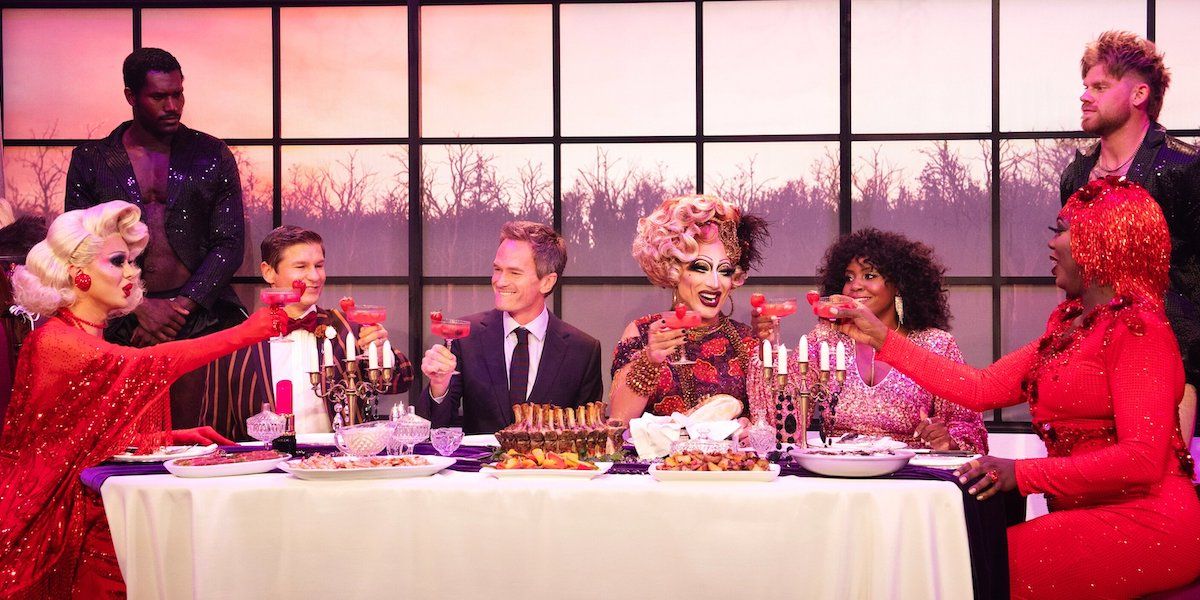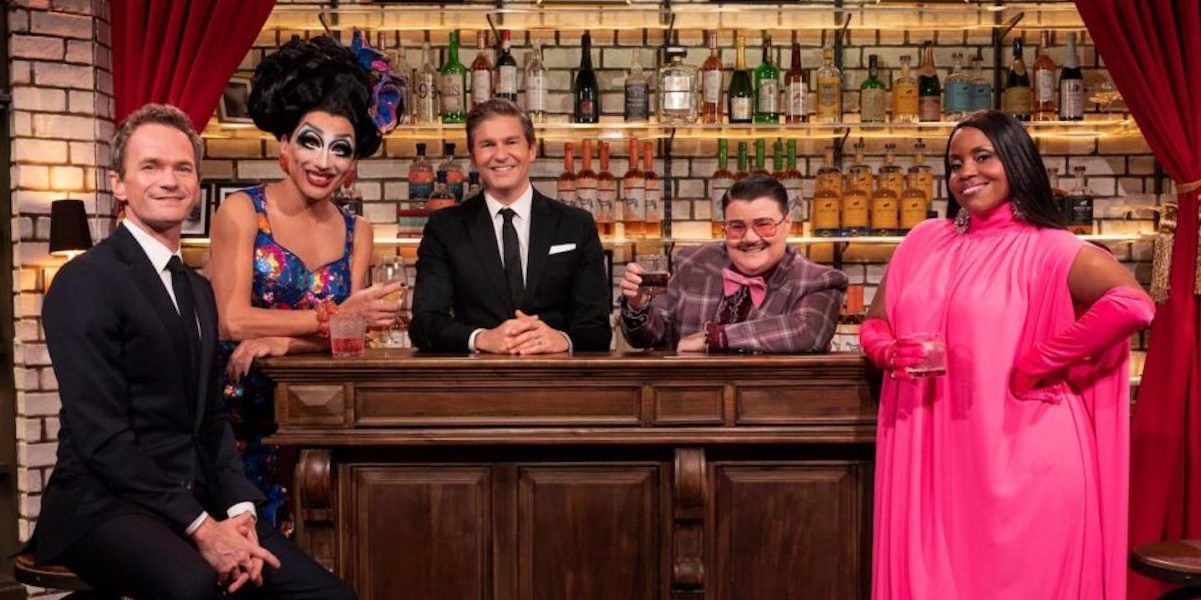It goes without saying that RuPaul’s Drag Race redefined the relationship between drag and the mainstream. And while the reality competition series showcases the incomparable talents of its performers, their appearances on the show are entangled in the high-stakes structure of the format. For those needing a reprieve from the high-pressure nature of RPDR, there is Hulu’s new series Drag Me to Dinner. Unlike Drag Race, Drag Me to Dinner mocks the former’s format with a faux contest where two pairs of drag queens “compete” to throw the best dinner party. The parties, which are really campy sketches, are humorously assessed by the show’s panel of “judgers”: Neil Patrick Harris, Bianca Del Rio, Haneefah Wood, David Burtka, and host Murray Hill. By sending up the conventions of competition television while showcasing the immense talents of its contestants, Drag Me to Dinner is the perfect low-stakes complement to Drag Race.
- Bethenny Frankel Talks About Being Despised by Andy Cohen
- ‘RHOP’ Alum Monique Samuels Files For Divorce Months After Denying Split From Chris Samuels
- 10 Best Competitive Reality Shows to Watch If You Liked ‘Next in Fashion’
- ‘Selling Sunset’ Season 6 Deserves a Reunion Episode
- You Can Move in With the ‘Brady Bunch’ — One of TV’s Most Iconic Homes Is for Sale
‘Drag Me to Dinner’ Sends up Reality Competition Conventions
As with most reality competition shows, Drag Me to Dinner features interview introductions to the contestants at the beginning of each episode. Rather than attempt to create any sort of empathetic response in the viewer that motivates the audience to root for the contestant, as is the goal of most contestant packages, these introductions simply serve as a vehicle for the pairs of queens to banter with one another. For example, when Jaida Essence Hall and Heidi N Closet introduce themselves as sisters in the eighth episode, “Slumber Party,” Hall says, “She says, ‘sister,’ I say, ‘bully.’” Closet responds, “I can’t bully you—look at your shoulders.” From the beginning of each episode’s competition, then, there is a break from the competition structure’s expected sincerity.
Since the competition’s structure is dependent on a grand prize for the show’s winner, Drag Me to Dinner mocks this convention by having the queens compete for a meaningless trophy. Each episode ends with one pair of queens “winning” the Golden Grater, a gold-painted cheese grater given to the team that is greater than the other. Additionally, when Hill introduces the prizes the queens are competing for each week, he lists a series of nonsensical items that, though depicted in a showcase-style montage, are never mentioned when the Golden Grater is bestowed on a pair of queens. These prizes, such as a Cher-cuterie board, eau de Harry Styles, and 55 gallons of lube, are, therefore, just presented for the amusement of the audience.
No competition series would be complete without the challenge that requires the contestants to compete against one another. Drag Me to Dinner laughs in the face of these challenges by having the queens throw faux dinner parties. Each pair is given ninety minutes to determine a sub-theme, create a menu, decorate a room, prepare entertainment, mix a signature cocktail, and cook all the food. Now, anyone who has ever done any single thing knows it is physically impossible to do all these things in an hour and a half. The show jokingly plays with the time constraints by having Hill shout out their remaining time, introducing an obstacle if the queens lose a trivia question (in the form of the bumbling Sue Chef, who is Burtka in drag), and having the queens absolutely destroy their meals as they cook them. For instance, while making their pork crown roast in “Whoring 20s,” the second episode, Trinity the Tuck and BeBe Zahara Benet drop eggs, shells and all, into a blender. When Trinity pours the blender’s contents over the roast, the blade cutter falls into the pan with the sauce, and Trinity leaves it in the pan to cook. By mocking the challenge which structures the competition itself, Drag Me to Dinner laughs at the high stakes of other reality competitions.
‘Drag Me to Dinner’s Self-Reflexivity Makes It Clear There Is Nothing Serious Here
Even if a viewer was somehow to take the show’s competition at face value, Drag Me to Dinner makes sure to punctuate its lack of seriousness by laughing at its own production. In the first episode, “Tropical Kiki,” the judgers attend a party hosted by Jinkx Monsoon and BenDeLaCreme. When the judgers discuss their sandcastle cake, David Burtka asks, “It’s edible on this island?” Monsoon begins her response, “Anything’s edible,” but as she delivers her punchline, “If you try hard enough,” BenDeLaCreme simultaneously says, “If you put it in your mouth and eat it.” Monsoon looks at BenDeLaCreme and asks, “Should we do that again and not talk over each other?” When Monsoon delivers the line a second time, neither queen delivers a punchline, which prompts character-breaking laughter from the cast.
see more : Kim Kardashian Reacts to Sister Kourtney Kardashian’s Surprise Pregnancy Announcement
If, by some stretch of the imagination, a viewer was to take this moment as just part of the improv process, the show goes even further to self-reflexively demonstrate its own inauthenticity. In the fifth episode, “Divorce Party,” queens Latrice Royale and Manila Luzon host a divorce-themed dinner. When Wood asks the queens to give her the recipe for their lemon pepper chicken, Luzon responds, “Well, you can watch Hulu on Drag Me to Dinner, and you can get the recipe there.” After a cut, a producer interjects to ask the performers to try the lines again. In the shot with the producer, the set, cameras, and crew are all visible. A cut back to the dinner sketch finds Wood and Luzon once again trying to complete their banter, but again a producer interjects. Luzon continues to deliver her line with the cast laughing, work shopping the joke, and commenting on how long they have been trying to get this shot. By revealing—and reveling in—the show’s own construction as a show, Drag Me to Dinner distances the audience from any sense that what is on-screen is to be taken seriously.
‘Drag Me to Dinner’ Is a Showcase for Camp Drag Talent
The only thing that can be taken seriously about Drag Me to Dinner is the talent of the drag cast. The show serves as a showcase for camp drag through the queens’ witty humor, over-the-top aesthetics, and entertainment prowess, all without the tension-filled fighting of Drag Race. For fans of Drag Race, Drag Me to Dinner is filled with RPDR alumni, from original winner Benet to walking memes like Vanessa “Ms. Vanjie” Mateo. The cast is especially timely because several of Drag Me to Dinner’s queens are also competing on the currently streaming eighth season of RuPaul’s Drag Race All-Stars. For queens like Mrs. Kasha Davis and Darienne Lake, Drag Me to Dinner highlights their campy comedic chops rather than situate them as early eliminations, as done in All-Stars. Additionally, whereas All-Stars’ high stakes and high pressure led to Closet’s withdrawal from the competition, she gets the chance to buoyantly light up the screen, stress-free, in Drag Me to Dinner.
Beyond the Drag Race alumni, Drag Me to Dinner also gives a platform to iconic non-Drag Race performers like Peaches Christ, the late Heklina, and, perhaps most importantly, host Murray Hill. Whereas Drag Race excludes drag kings from the stage, Drag Me to Dinner puts Hill front and center for each episode. By showcasing a diverse array of drag talent without forcing them to actually compete for recognition and money, and through its sending up of reality competition conventions, Drag Me to Dinner is the perfect representation of drag as pure entertainment.
Source: https://dominioncinemas.net
Category: REALITY TV












